Â
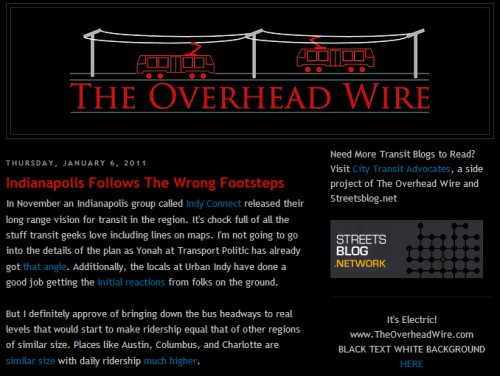 This morning I woke up, and there was a wonderful link sitting in my email inbox. It was a link to the Overhead Wire, and an outside analysis by them of the Indyconnect plan. The Overhead Wire specifically took on the NE Corridor and compared it to the Capital Metrorail in Austin, TX. In their post, they compared how the Austin line skirts the downtown area. Since Austin’s commuter line opening earlier this year, it has been the target of repeated criticism about how poor a design it is and that it is a major display of political letdown. Sound familiar? If you live in Indianapolis, all you have to do is surf over to the Indyconnect webpage, and see where the NE Corridor line is routed; because it’s headed down the same road to where Austin already is.  They even created some decent graphics comparing the two lines.
This morning I woke up, and there was a wonderful link sitting in my email inbox. It was a link to the Overhead Wire, and an outside analysis by them of the Indyconnect plan. The Overhead Wire specifically took on the NE Corridor and compared it to the Capital Metrorail in Austin, TX. In their post, they compared how the Austin line skirts the downtown area. Since Austin’s commuter line opening earlier this year, it has been the target of repeated criticism about how poor a design it is and that it is a major display of political letdown. Sound familiar? If you live in Indianapolis, all you have to do is surf over to the Indyconnect webpage, and see where the NE Corridor line is routed; because it’s headed down the same road to where Austin already is.  They even created some decent graphics comparing the two lines.
Indianapolis – Left Yellow is the University, Middle Yellow is Downtown, State Capital and the red line is the commuter rail.
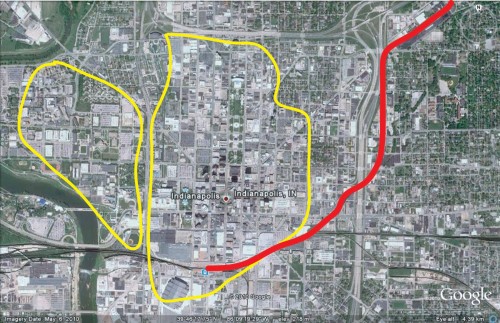
Austin – Top Yellow is University of Texas, Bottom Yellow is State Capital and Downtown
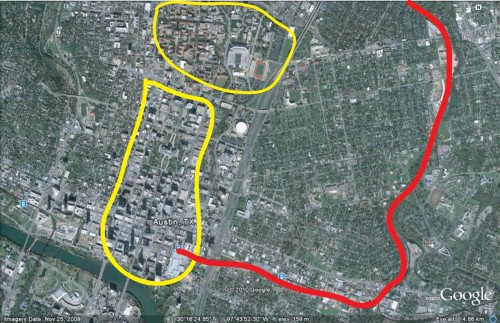
They wrapped up by suggesting a route where rail should really go.
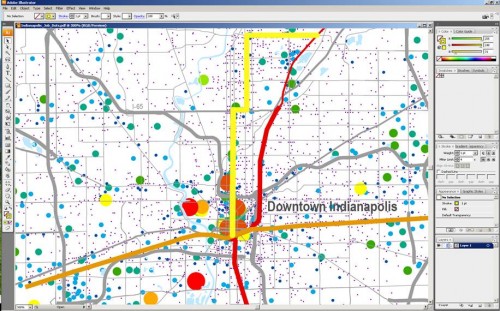
 Oddly enough, it looks like a graphic that I posted last week in a freight study released in September. You can see plainly enough that the same yellow line was drawn on the map.
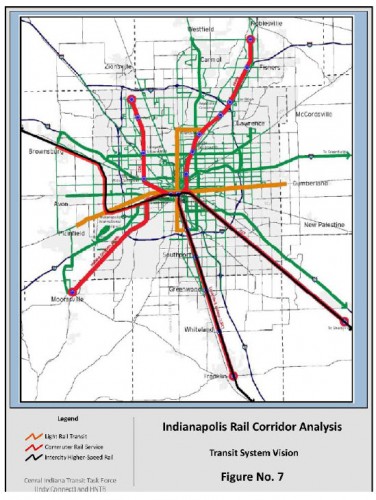
But as is the case, there simply isn’t enough money to make this a reality right now. Essentially, we get a short term political win, and long term struggle for those of us pushing for the implimentation of rail in Indianapolis proper. I posted about this same topic in March back at my own blog comparing what could happen. I want to send a thanks to the folks at The Overhead Wire for lending an opinion on this. This post is a lot of what they said, and my hopes are that locals can be exposed to this outside opinion.
The jobs concentration image is what really hits home for me. It’s a COMMUTER line. It should connect people to jobs. The NE Corridor does a poor job of connecting to high concentrations of either.
I don’t think it is valid to compare the NE corridor to Austin’s or any other light rail line. Such comparisons keep getting made because of the use of the water-muddying term ‘light rail.’ The NE Corridor will be a diesel-powered heavy rail commuter line, like Metra in the Chicago area. Despite the hopes that transit enthusiasts pin on it, its main purpose will always be to bring weekday commuters from Fishers to the downtown core. And the only reason that it is under consideration is that the right-of-way already exists. If one yard of new rail had to be built, the whole line would be considered to unrealistic to consider right now.
None of which is a bad thing, since it is only one part of a comprehensive plan that includes improved bus service and, eventually, at least one streetcar (let’s refrain from calling this one ‘light rail’ too). Marion County dwellers who need to get to IUPUI, hospitals, or the near-north of downtown, would use the more frequent and more direct bus service envisioned in the same plan. Including the NE Corridor in the plan just as it is, accomplishes three things:
-Gets said suburbanites to work
-Brings their tax money with them, to the benefit of the entire transit network
-Provides a quick, cheap win that proves the interest of ridership. This could improve the likelihood that one day new lines will serve the areas in yellow above.
flavius, what’s 1/4 to 1/2 of 1% of Hamilton County’s retail sales? How does that compare to Marion County’s? I keep reading the “suburban tax money” argument, but no one ever puts a number to it.
.
I think Marion County could self-fund the majority of proposed bus improvements without the HamCo money on the table, but again…without costs and revenues, it is hard to make that determination from the outside.
.
I’ll say again: if there’s to be BRT in IndyConnect, the “cheap/easy fast win” would be to run BRT on a dedicated busway on the NE line. And that’s more appropriate, given the current ridership numbers on the Fishers Express.
You make some valid points flavius. However, there is an easy parallel made here in comparing how both plans skirt the activity centers.
When it comes down to measuring the success of a rail line, the first metric is ALWAYS dail ridership. Do you expect the NE Corridor line to attract 10K+ riders a day? Will it be closer to 2K? And if so, can we say that its a successful line at that point when there are bus lines in town that carry more people per day?
The Overhead Wire’s post is a valid argument to have about this line. The byproduct of low ridreship is poor citizen sentiment which always puts further investment into rail transit at risk.
To define a success, you also have to figure in the investment required to build and maintain it. NE Corridor will probably (depending on factors that are not yet decided) cost a fraction of Austin’s light rail line. And even with only 2000 riders, it should save about 100,000 gallons of gas a year.
I agree completely that it skirts the activity centers. All I’m saying is that it doesn’t have to be this line’s job to serve them.
The Austin line was biult for around $108 million. The NE Corridor will cost MORE than that to build.
Maybe we should build ours like chicago,newyork,jacksonville,philadelphia and a few other cities including our clarion hospitol people mover , and build it above ground . And build the depo passinger pick ups and get offs above and under ground like these other cities , besides its better,safer, looks cool to see the trains passing around and through the center city and for indys sake would truly show its big city masklin status.
The Austin line is also diesel powered commuter rail, not light rail…